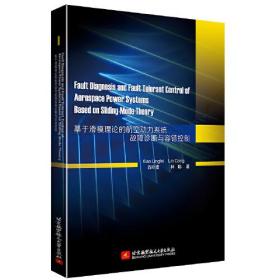
Fault Diagnosis and Fault Tolerant Control of Aer 9787512436282
正版图书,可开发票,请放心购买。
¥ 60.65 7.7折 ¥ 79 全新
库存4件
作者肖玲斐 林聪 著
出版社北京航空航天大学出版社
ISBN9787512436282
出版时间2022-03
装帧平装
开本16开
定价79元
货号29389975
上书时间2024-10-21
- 最新上架
商品详情
- 品相描述:全新
- 商品描述
-
前言
Aerospace power systems provide the thrust of forward movement and the necessary speed to lift off for aircrafts. The most important part in an aerospace power system is the aircraft engine. With the development of science and technology in various countries, people have higher and higher requirements on the control performance of aerospace power systems,which undoubtedly increases the control difficulty of aerospace power systems.
Sliding mode theory includes sliding mode controller design method and sliding mode observer design method. Because of the good robustness and relatively simple strategy,sliding mode theory has attracted more and more attentions all around world from science researchers to engineering technicians.
The control systems in modern aircraft engines are carried out by Full Authority Digital Electronic Control (FADEC) systems. The FADEC needs to work with the signal measured by the relevant sensors on the aircraft engine, which contains a large number of electronic components, sensors and actuators. Most of these components work in the working environment of high temperature, high pressure and alternating stress of aircraft engine, which makes them prone to failure and several faults occur frequently. Once serious faults occur, the consequence may be unimaginable. Therefore, fault diagnosis and fault tolerant control for aerospace power system is particularly important.
In view of this, we write this book by summarizing years of scientific research results,focusing on the sliding mode theory for the fault diagnosis and fault tolerant control of aerospace power systems.
Focussing on the fault diagnosis and fault tolerant control problems in aerospace power systems, this book introduces a variety of sliding mode observer design, sliding mode controller design and sliding mode fault tolerant control system construction methods.Correspondingly, except the Chapter 1, which is the introduction, there are three parts in this book. The first part includes six chapters, which discuss fault diagnosis of aerospace power systems. The second part includes five chapters and different sliding mode control methods are presented for aerospace power systems. The third part, which is comprised of seven chapters, shows several fault tolerant control methods for aerospace power systems.
We sincerely thank our students and friends. Thank you for your help and support in writing this book.
In the process of editing and publishing this book, many staff in Beihang University Press have worked hard, and we would like to express our gratitude here also.
Limited to our ability, this book is inevitably inadequate or even wrong, and we urge readers, experts and scholars from all areas to criticize and correct us.
Xiao Lingfei and Lin Cong
June 11,2021
导语摘要In the field of aerospace power systems, there are few books on fault diagnosis and fault tolerant control based on sliding mode theory. On the basis of authors many years of technical research and the results of many scientific research projects, this book comprehensively expounds the key theories and main methods of fault diagnosis and fault tolerant control of aerospace power systems based on sliding mode theory. Several design methods for sliding mode observers and sliding mode controllers are introduced, and are utilized to realize fault diagnosis and fault tolerant control for some typical aerospace power systems. This book has remarkable characteristics of combining theory with engineering.Except the Chapter 1 which is the introduction, there are three parts in this book. The first part is about fault diagnosis methods for aerospace power systems, which includes six chapters. The second part includes five chapters and different sliding mode control methods for aerospace power systems are given. The third part is comprised of the remaining seven chapters, in which several fault tolerant control methods for aerospace
power systems are discussed.
This book can be used as reference book for scientific researchers, engineering technicians, teachers and senior undergraduates, masters and doctoral students, who are in the field of aerospace, automation, power machinery and engineering, specially enengaged in the research and application of system modeling,control,fault diagnosis, fault tolerance,etc.
商品简介In the field of aerospace power systems, there are few books on fault diagnosis and fault tolerant control based on sliding mode theory. On the basis of authors many years of technical research and the results of many scientific research projects, this book comprehensively expounds the key theories and main methods of fault diagnosis and fault tolerant control of aerospace power systems based on sliding mode theory. Several design methods for sliding mode observers and sliding mode controllers are introduced, and are utilized to realize fault diagnosis and fault tolerant control for some typical aerospace power systems. This book has remarkable characteristics of combining theory with engineering.Except the Chapter 1 which is the introduction, there are three parts in this book. The first part is about fault diagnosis methods for aerospace power systems, which includes six chapters. The second part includes five chapters and different sliding mode control methods for aerospace power systems are given. The third part is comprised of the remaining seven chapters, in which several fault tolerant control methods for aerospace
power systems are discussed.
This book can be used as reference book for scientific researchers, engineering technicians, teachers and senior undergraduates, masters and doctoral students, who are in the field of aerospace, automation, power machinery and engineering, specially enengaged in the research and application of system modeling,control,fault diagnosis, fault tolerance,etc.
目录Chapter 1 Introduction 1
1.1 Fault Diagnosis and Fault Tolerant Control Theory 1
1.1.1 Faults Classification 1
1.1.2 Fault Diagnosis 5
1.1.3 Fault Tolerant Control 7
1.2 Sliding Mode Theory 11
1.2.1 Sliding Mode Control 11
1.2.2 Sliding Mode Observer 12
1.3 Fault Diagnosis and Fault Tolerant Control Based on Sliding Mode 13
1.3.1 Fault Diagnosis Based on Sliding Mode Observer 13
1.3.2 Sliding Mode Fault Tolerant Control 14
1.4 Fault Diagnosis and Fault Tolerant Control in Aircraft Power Systems 15
1.4.1 Sliding Mode Fault Diagnosis in Aircraft Power Systems 15
1.4.2 Sliding Mode Fault Tolerant Control in Aircraft Power Systems 16
1.5 Structure of This Book 16
Chapter 2 Aircraft Engine Sensor Faults Diagnosis Based on Sliding Mode Observer by Using Residual 18
2.1 Aircraft Engine Mathematical Model 18
2.1.1 Aircraft Engine Linear Model 18
2.1.2 Establishment of Aircraft Engine State Space Variable Model Based on Least Square Fitting 21
2.2 Mathematical Model of Sensor Fault in Aircraft Engine 23
2.3 Fault Diagnosis Method Based on Residual Error 23
2.3.1 System Model with Sensor Faults 24
2.3.2 Observer Design and Stability Analysis 24
2.3.3 Parameter Solution of Sliding Mode Observer Based on Linear Matrix Inequality 25
2.3.4 Sensor Fault Detection Based on Sliding Mode Observer 27
2.4 Simulation 28
2.5 Conclusions 31
Chapter 3 Multi-sensors Fault Diagnosis of Aircraft Engine Based on Kalman Filter Group 32
3.1 Introduction 32
3.2 Aircraft Engine Model 33
3.3 Design of Sensor Fault Diagnosis System for Aircraft Engine 35
3.3.1 Single Sensor Fault Diagnosis 35
3.3.2 Multi-sensors Fault Diagnosis 36
3.4 Simulation 37
3.5 Conclusions 46
Chapter 4 Fault Identification for Turboshaft Engines Based on Fractional-order Sliding Mode Observer 47
4.1 Introduction 47
4.2 Turboshaft Engine Linearized Model 48
4.3 Fault Identification Based on Fractional-order Sliding Mode Observer 49
4.4 Simulation 51
4.5 Conclusions 55
Chapter 5 Robust Fault Identification of Turbofan Engine Sensors Based on Fractional-order Integral Sliding Mode Observer 56
5.1 Introduction 56
5.2 Equilibrium Manifold Expansion Model of Turbofan Engine 57
5.3 Fractional-order Integral Sliding Mode Observer for Fault Identification 58
5.3.1 Preliminaries of Fractional-order Calculus 58
5.3.2 Design of Fractional-order Integral Sliding Mode Observer 59
5.4 Simulation 64
5.5 Conclusions 70
Chapter 6 Aircraft Engine Gas Path Fault Diagnosis Based on HPSO-TWSVM 71
6.1 Introduction 71
6.2 A Description of Aircraft Engine Gas Path Fault Diagnosis 71
6.3 Basic Principle of TWSVM 73
6.4 Algorithm of TWSVM Based on HPSO-TWSVM 74
6.4.1 Characters and Principle of HPSO 74
6.4.2 Selection of Kernel Function 77
6.4.3 Training Algorithm of TWSVM 78
6.5 Gas Path Fault Diagnosis Based on HPSO-TWSVM 79
6.5.1 Review of Gas Path Fault Diagnosis Based on HPSO-TWSVM 79
6.5.2 Procedure of Gas Path Fault Diagnosis Based on HPSO-TWSVM 80
6.6 Simulation 82
6.7 Conclus
相关推荐
-
![现货Fault-diagnosis Systems: An Introduction[9781781546888]](https://www0.kfzimg.com/sw/kfz-cos/kfzimg/17733071/231f65f9aa857942_s.jpg)
现货Fault-diagnosis Systems: An Introduction[9781781546888]
九五品上海
¥ 1867.00
-

Intelligent Fault Diagnosis and
九五品信阳
¥ 1440.00
-

electronic fault diagnosis (4th Edition)
八品成都
¥ 160.00
-

Fault Diagnosis in Data Communications Systems
八品汕头
¥ 10.00
-

Fault Detection and Diagnosis in Industrial Systems
八五品淮安
¥ 50.00
-

FAULT DIAGNOSIS IN DATA COMMUNICATIONS SYSTEMS 5731
八五品北京
¥ 12.00
-

FAULT DIAGNOSIS IN DATA COMMUNICATIONS SYSTEMS 5756
八五品北京
¥ 12.00
-

Fault Diagnosis and Fault Tolerant Control of Aer
全新天津
¥ 57.90
-

Competent Expert Systems: A Case Study in Fault Diagnosis
八品汕头
¥ 15.00
-
![现货 Bayesian Networks in Fault Diagnosis: Practice and Application[9789813271487]](https://www0.kfzimg.com/sw/kfz-cos/kfzimg/17733071/981cb2c45a94c8b0_s.jpg)
现货 Bayesian Networks in Fault Diagnosis: Practice and Application[9789813271487]
九五品上海
¥ 1274.00
— 没有更多了 —













以下为对购买帮助不大的评价